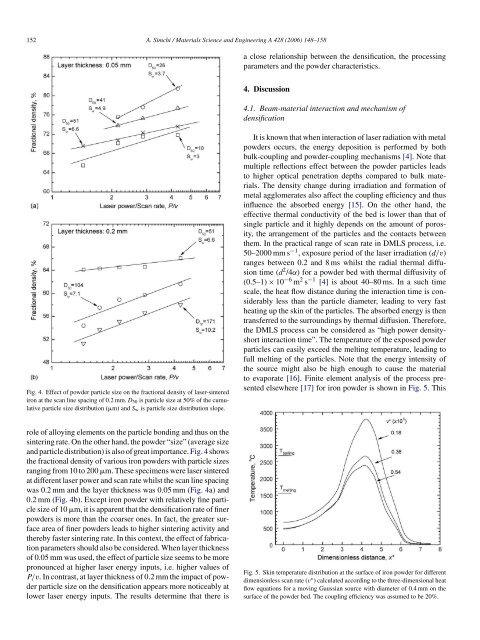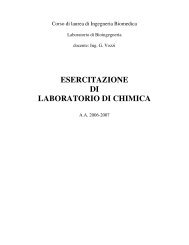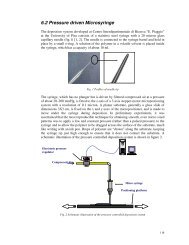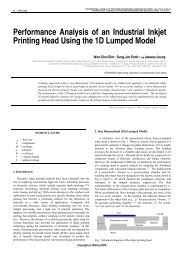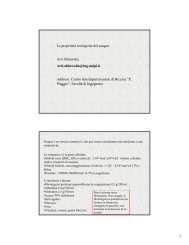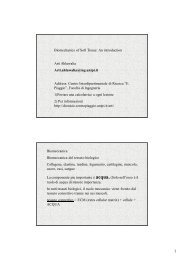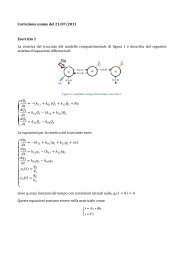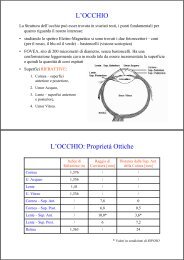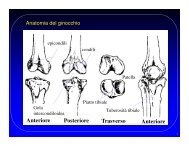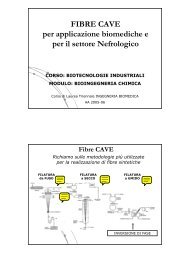Direct laser sintering of metal powders: Mechanism, kinetics and ...
Direct laser sintering of metal powders: Mechanism, kinetics and ...
Direct laser sintering of metal powders: Mechanism, kinetics and ...
- No tags were found...
Create successful ePaper yourself
Turn your PDF publications into a flip-book with our unique Google optimized e-Paper software.
152 A. Simchi / Materials Science <strong>and</strong> Engineering A 428 (2006) 148–158a close relationship between the densification, the processingparameters <strong>and</strong> the powder characteristics.4. Discussion4.1. Beam-material interaction <strong>and</strong> mechanism <strong>of</strong>densificationFig. 4. Effect <strong>of</strong> powder particle size on the fractional density <strong>of</strong> <strong>laser</strong>-sinterediron at the scan line spacing <strong>of</strong> 0.2 mm. D 50 is particle size at 50% <strong>of</strong> the cumulativeparticle size distribution (m) <strong>and</strong> S w is particle size distribution slope.It is known that when interaction <strong>of</strong> <strong>laser</strong> radiation with <strong>metal</strong><strong>powders</strong> occurs, the energy deposition is performed by bothbulk-coupling <strong>and</strong> powder-coupling mechanisms [4]. Note thatmultiple reflections effect between the powder particles leadsto higher optical penetration depths compared to bulk materials.The density change during irradiation <strong>and</strong> formation <strong>of</strong><strong>metal</strong> agglomerates also affect the coupling efficiency <strong>and</strong> thusinfluence the absorbed energy [15]. On the other h<strong>and</strong>, theeffective thermal conductivity <strong>of</strong> the bed is lower than that <strong>of</strong>single particle <strong>and</strong> it highly depends on the amount <strong>of</strong> porosity,the arrangement <strong>of</strong> the particles <strong>and</strong> the contacts betweenthem. In the practical range <strong>of</strong> scan rate in DMLS process, i.e.50–2000 mm s −1 , exposure period <strong>of</strong> the <strong>laser</strong> irradiation (d/v)ranges between 0.2 <strong>and</strong> 8 ms whilst the radial thermal diffusiontime (d 2 /4α) for a powder bed with thermal diffusivity <strong>of</strong>(0.5–1) × 10 −6 m 2 s −1 [4] is about 40–80 ms. In a such timescale, the heat flow distance during the interaction time is considerablyless than the particle diameter, leading to very fastheating up the skin <strong>of</strong> the particles. The absorbed energy is thentransferred to the surroundings by thermal diffusion. Therefore,the DMLS process can be considered as “high power densityshortinteraction time”. The temperature <strong>of</strong> the exposed powderparticles can easily exceed the melting temperature, leading t<strong>of</strong>ull melting <strong>of</strong> the particles. Note that the energy intensity <strong>of</strong>the source might also be high enough to cause the materialto evaporate [16]. Finite element analysis <strong>of</strong> the process presentedelsewhere [17] for iron powder is shown in Fig. 5. Thisrole <strong>of</strong> alloying elements on the particle bonding <strong>and</strong> thus on the<strong>sintering</strong> rate. On the other h<strong>and</strong>, the powder “size” (average size<strong>and</strong> particle distribution) is also <strong>of</strong> great importance. Fig. 4 showsthe fractional density <strong>of</strong> various iron <strong>powders</strong> with particle sizesranging from 10 to 200 m. These specimens were <strong>laser</strong> sinteredat different <strong>laser</strong> power <strong>and</strong> scan rate whilst the scan line spacingwas 0.2 mm <strong>and</strong> the layer thickness was 0.05 mm (Fig. 4a) <strong>and</strong>0.2 mm (Fig. 4b). Except iron powder with relatively fine particlesize <strong>of</strong> 10 m, it is apparent that the densification rate <strong>of</strong> finer<strong>powders</strong> is more than the coarser ones. In fact, the greater surfacearea <strong>of</strong> finer <strong>powders</strong> leads to higher <strong>sintering</strong> activity <strong>and</strong>thereby faster <strong>sintering</strong> rate. In this context, the effect <strong>of</strong> fabricationparameters should also be considered. When layer thickness<strong>of</strong> 0.05 mm was used, the effect <strong>of</strong> particle size seems to be morepronounced at higher <strong>laser</strong> energy inputs, i.e. higher values <strong>of</strong>P/v. In contrast, at layer thickness <strong>of</strong> 0.2 mm the impact <strong>of</strong> powderparticle size on the densification appears more noticeably atlower <strong>laser</strong> energy inputs. The results determine that there isFig. 5. Skin temperature distribution at the surface <strong>of</strong> iron powder for differentdimensionless scan rate (v ∗ ) calculated according to the three-dimensional heatflow equations for a moving Gaussian source with diameter <strong>of</strong> 0.4 mm on thesurface <strong>of</strong> the powder bed. The coupling efficiency was assumed to be 20%.


